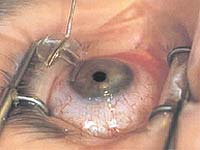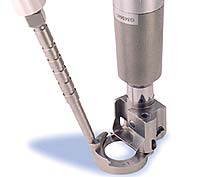Measure stromal bed to ensure proper flap thickness
A study found slightly more variation in thickness with the Hansatome than with the Moria microkeratome.
LOS ANGELES — In cases of high refractive error with corneas of borderline or average thickness, accurate flap thickness may be crucial when performing laser in situ keratomileusis (LASIK). However, the microkeratome’s labelled flap thickness is rarely the actual thickness produced, according to a study performed here.
In such cases, measuring the stromal bed intraoperatively can help avoid leaving a stromal bed that is too thin, and the risk of corneal ectasia.
“It is well known that the keratome head, which is supposed to determine flap thickness, rarely produces the stated flap thickness,” said James J. Salz, MD, a clinical professor of ophthalmology at the University of Southern California here. “Most of the time, the flap thickness is thinner. The rule of thumb is that you want to leave 250 µm in the stromal bed to have a safe cornea, so you don’t develop ectasia.”
To more accurately measure corneal flap thickness, Dr. Salz uses an ultrasonic pachymeter manufactured by Sonogage (Cleveland, Ohio).
“This pachymeter is particularly good at measuring. You simply touch it to the cornea, and, in a split second, it gives you a reading, without having to wet the cornea,” he said. “Some of the past pachymeters wouldn’t give you a reading unless the cornea was sort of moist. With this new pachymeter, you don’t need to hydrate the stroma.” Another problem with previous pachymeters is that “they were unable to accurately measure less than about 330 µm,” Dr. Salz said.
Study compares three blades
 ---Scar in Bowman’s
layer seen 1 week after creation of a 55-µm LASIK flap.
---Scar in Bowman’s
layer seen 1 week after creation of a 55-µm LASIK flap.
Dr. Salz was principal investigator of a study that compared the two
heads (180 µm and 160 µm) of the Hansatome (Bausch & Lomb
Surgical, Claremont, Calif.) microkeratome with the 130-µm head of the
Moria (Doylestown, Pa.) Carriazo-Barraquer microkeratome.
“These are two systems that I use all the time,” Dr. Salz said. “Moria tells us that the 130-µm head is supposed to provide us with about a 150-µm flap.” Co-investigators were Jane Ge, MD, and Ray Oyakawa, MD.
The study comprised 281 eyes (183 eyes for the Hansatome-180, 47 for the Hansatome-160 and 51 for the Carriazo-Barraquer-130). Preoperative keratometry readings were based on EyeSys topography, and LASIK was carried out in the usual fashion. Flap thickness was calculated by subtracting stromal bed thickness from corneal thickness.
“Basically, we found that, with the Hansatome 180-µm head, our average flap thickness was 139 µm. But, the range was 55 µm all the way up to 207 µm, with a standard deviation of 28 µm,” Dr. Salz said. The Hansatome-160 produced a mean of 110 µm, with a similar range of 57 to 157 µm and a standard deviation of 28 µm.
On the other hand, the Carriazo-Barraquer-130 microkeratome had a mean of 152 µm, with a range of 107 to 203 µm and a standard deviation of only 21 µm. “We had no super-thin flaps with this unit,” Dr. Salz said.
Thin flap
 ---Stromal bed thickness
can be measured intraoperatively with a Sonogage
pachymeter.
---Stromal bed thickness
can be measured intraoperatively with a Sonogage
pachymeter.
“We think that the flap thickness measurements
are accurate because in the case that had a measured flap of 55 µm, one
would have expected to see a buttonhole. There was no buttonhole evident at the
time of surgery, so the ablation was performed; however, at 1 week, the outline
of a buttonhole was found at slit lamp examination, indicating that the flap
partially cut Bowman’s membrane,” Dr. Salz said. (See figure.)
“Results with any of these three heads can still be okay, depending on what parameters you wish to achieve,” said Dr. Salz, co-director of refractive surgery research at Cedars-Sinai Medical Center in Los Angeles. “We’ve learned from the study, though, that if I want to have a thin flap for a high correction, then I use the Hansatome microkeratome with the 160-µm flap. Of the three heads, the 160-µm head has the best chance of producing a thin flap. But because there is such a wide range, it does not guarantee that I’ll end up with a thin flap. After all, we had one flap that measured 200 µm with the 160-µm head. This would have definitely been a problem if I was seeking a 120-µm flap, because I would not have as much tissue to ablate.” One also could get the 110 head of the Carriazo-Barraquer cutting 130 µm.
On average, the Hansatome-160 produces a corneal flap that is 30 µm thinner than the Hansatome-180. “Most people agree that the best flap thickness is 150 µm, but we sometimes do not desire a 150-µm flap because then we don’t have as much tissue to ablate,” Dr. Salz said.
Ring sizes
 ---The Moria
Carriazo-Barraquer microkeratome uses blades set for a 130-µm
flap.
---The Moria
Carriazo-Barraquer microkeratome uses blades set for a 130-µm
flap.
The Hansatome microkeratome comes in two ring sizes: 8.5
mm and 9.5 mm. “This does not allow you to adjust for changes in corneal
curvature,” Dr. Salz said. “You use the same basic ring whether you
have a flat cornea or a steep cornea.” In contrast, the Carriazo-Barraquer
microkeratome has five separate rings; therefore, “if you have an
unusually flat cornea, you can select a ring that is more likely to provide you
with an adequate flap,” Dr. Salz said. The ring size of the
Carriazo-Barraquer is also slightly smaller than the ring size of the
Hansatome, “so in eyes that have tight lids or deep-set eyes, we feel the
ring is easier to place in the eye.”
Correlation between flap, thickness
 ---The Bausch & Lomb
Hansatome microkeratome can use 160-µm or 180-µm
blades.
---The Bausch & Lomb
Hansatome microkeratome can use 160-µm or 180-µm
blades.
The study found that there is no significant correlation
between flap thickness and keratometry. “Our flap thickness did not vary
in any predictable way,” Dr. Salz said. However, “there was a weak
statistical correlation between flap thickness and corneal thickness. Thicker
corneas tended to produce slightly thicker flaps, and thinner corneas tended to
produce thinner flaps. But there were exceptions, so it is not a strong
correlation.”
In conclusion, “we found both the Hansatome and the Carriazo-Barraquer microkeratome to be reliable. We didn’t experience major flap problems with either microkeratome,” Dr. Salz said. In addition, both microkeratomes “produce superiorly hinged flaps.” Still, there were “a small number of abrasions with both.”
More important than the individual microkeratome, however, “is knowing what results that particular keratome will give you in your hands, despite what the manufacturer says,” Dr. Salz said. “If a surgeon is going to invest in anything, he or she should invest in a good ultrasonic pachymeter.”
| Comparison of microkeratomes for flap thickness | |||
| Microkeratome | Moria Carriazo-Barraquer 130-µm head |
Hansatome 180-µm head | Hansatome 160-µm head |
| Mean flap thickness (µm) | 152 | 139 | 110 |
| Standard deviation (µm) | 21 | 28 | 28 |
| Range (µm) | 107-203 | 55-207 | 57-157 |
For Your Information:
- James J. Salz, MD, can be reached at 8635 West Third St., Ste. 390 W., Los Angeles, CA 90048; (310) 652-1133; fax: (310) 657-1719; e-mail: jjsalzeye@aol.com.
- Sonogage Inc. can be reached at 26650 Renaissance Pkwy, Suite 3, Cleveland, OH 44128; (800) 798-1119; (216) 464-1119; fax: (219) 831-3444; e-mail: sonogage@prodigy.net: Web: www.sonogage.com.
